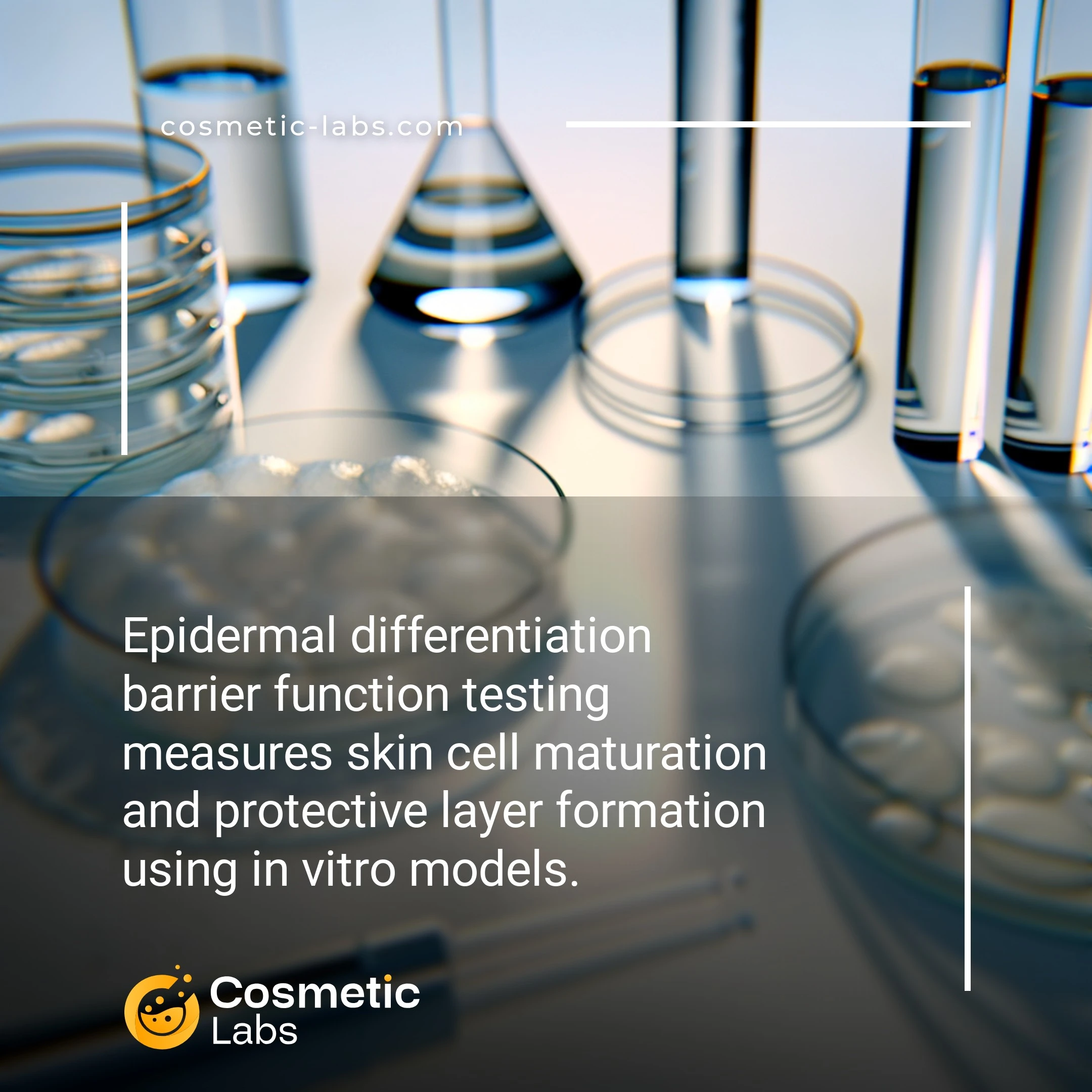Epidermal Barrier Testing Services for Cosmetic Brands

What is Epidermal differentiation?
Epidermal differentiation barrier function testing measures how well cosmetic ingredients promote the natural maturation process of skin cells from the basal layer to the protective stratum corneum. Labs use keratinocyte culture models and transepidermal water loss measurements to evaluate whether your formulations enhance barrier proteins like filaggrin and ceramide production. This testing reveals if active ingredients actually strengthen skin’s moisture retention and protective capabilities, rather than just claiming barrier benefits without scientific proof.
Why do you need this service?
Cosmetic labs use epidermal differentiation assays to validate moisturizer claims by measuring keratinocyte maturation markers like filaggrin and loricrin expression in response to active ingredients. Beauty brands leverage these tests to demonstrate barrier repair efficacy within 14-21 days, generating the clinical data needed for marketing claims and regulatory submissions across anti-aging, sensitive skin, and repair product categories.
Who provides Epidermal differentiation services?
All cosmetic labs providing Epidermal differentiation services
There is no company providing these services at the moment.
Epidermal Differentiation Testing for Barrier Function Assessment
Epidermal differentiation testing measures how well cosmetic ingredients support the skin’s natural barrier formation process. Labs use specialized cell culture models to evaluate how formulations influence keratinocyte maturation and barrier protein expression.
Cell Culture Models for Differentiation Analysis
Labs employ 3D reconstructed epidermis models that mimic natural skin architecture. These models track differentiation markers like filaggrin, involucrin, and loricrin over 14-21 day culture periods.
Testing protocols include:
- Histological analysis of stratum corneum thickness
- Immunofluorescence staining for barrier proteins
- Gene expression profiling of differentiation markers
- Transepithelial electrical resistance measurements
Results show whether your ingredients accelerate or delay normal differentiation processes, helping optimize formulations for barrier repair products.
Barrier Protein Expression Profiling
Labs quantify specific proteins that form the skin’s protective barrier. Western blot analysis and qPCR testing measure claudin-1, occludin, and ceramide synthase levels after ingredient exposure.
Key measurements include:
- Tight junction protein concentrations
- Lipid synthesis enzyme activity
- Cornified envelope protein assembly
- Antimicrobial peptide production
This data helps brands understand how ingredients affect barrier formation at the molecular level. Contact labs on our platform to discuss differentiation testing protocols for your specific formulation needs.
Applications of Epidermal Differentiation Testing for Barrier Function Analysis
Cosmetic labs use epidermal differentiation testing for barrier function analysis to validate product claims and optimize formulations before market launch.
Anti-Aging Product Development
Labs evaluate how active ingredients influence keratinocyte differentiation pathways to strengthen skin barrier integrity. Testing protocols measure ceramide production, filaggrin expression, and tight junction protein formation in 3D skin models over 14-21 day periods.
This approach helps brands substantiate claims about barrier repair and moisture retention. Teams can identify optimal concentrations of retinoids, peptides, and botanical extracts that promote healthy epidermal stratification without causing irritation.
Sensitive Skin Formulation Validation
Specialized testing examines how formulations affect cornified envelope formation and lipid bilayer organization in compromised skin models. Labs use transepithelial electrical resistance (TEER) measurements and dye penetration assays to quantify barrier function improvements.
Results guide reformulation decisions for products targeting atopic dermatitis, rosacea, and post-procedure skin recovery. Testing typically shows barrier restoration within 7-10 days when formulations include appropriate ceramide ratios and pH buffers.
| Test Parameter | Measurement Method | Typical Timeline | Key Indicators |
|---|---|---|---|
| Ceramide Synthesis | ELISA quantification | 14-21 days | Ceramide 1, 3, 6 levels |
| Protein Expression | Western blot analysis | 7-14 days | Filaggrin, involucrin, loricrin |
| Barrier Integrity | TEER measurement | 3-7 days | Electrical resistance values |
| Permeability | Dye penetration assay | 24-48 hours | Fluorescent marker distribution |
Connect with specialized cosmetic labs on our platform to access epidermal differentiation testing services tailored to your product development needs.
